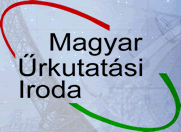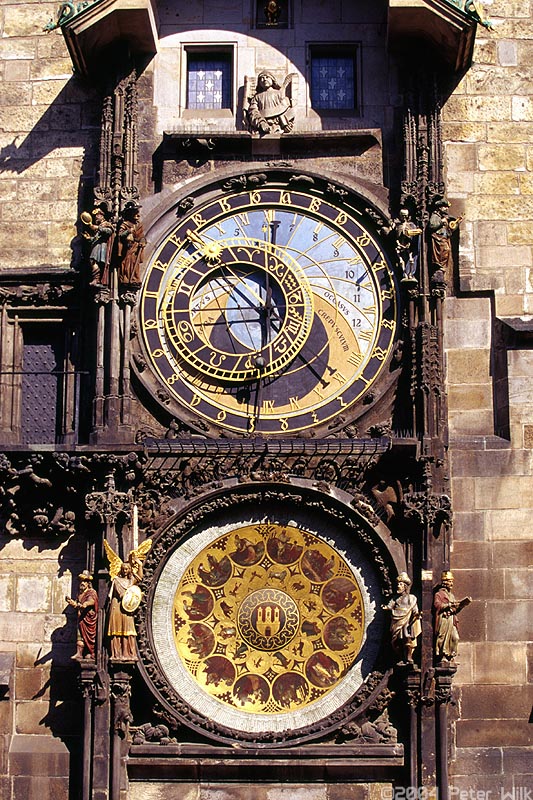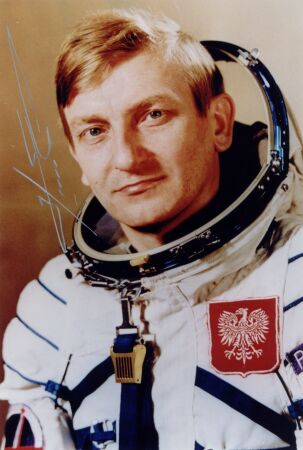


ESA Expansion into Central Europe
16 January, 2006 Jagiellonian University, Krakow, Poland
Click for Polish, Hungarian and Czech Space Offices

Today the Polish space industry, along with the Hungarian and the Czech, are experiencing a renewal phase thanks to the increased importance of hi-tech economic sectors as well as the benefit from being on the path to membership in the European Space Agency (ESA), to take place near the end of the decade.
Cosmology in Central Europe has been historically significant. Nicholas Copernicus of Torun proved in `The Revolutions of the Celestial Spheres' (1543) that the Sun does not move around the Earth, as previously thought, but that the Earth orbits the Sun, as is correct. 16th Century Prague hosted the work of Tycho Brahe, one of the great observers of the heavens, as well as Johannes Kepler. It also boasts a famous `Astronomical Clock,' in the old town square. In the 17th Century, Jan Hevelius of Gdansk made the best constellation and star charts until today's time, and named the only one of the 88 constellations added in modern times to the pre-existing antique canon: Sobieski's Shield (Scutum), in honor of the 1683 relief of Vienna. More recently, Konstantin Tsiolkovsky, was the son of a Polish nobleman exiled by the Russians to Siberia. His 1903 book, `Exploration of Cosmic Space by means of Reaction Devices,' introduced
to the world the principles of rocketry. In 1978 Czechoslovakia and Poland became the 3rd and 4th nations in the world (excepting the USSR and the USA) to send a man into space. Hungary put a man up in 1980.


During the interwar period, the Central European states developed new astronomical observatories outside of major university cities, and contributed to knowledge enhancement on a level basis with other Western countries. The war wrecked a lot of the regional infrastructure, but it was for the most part revitalized and expanded upon during the communist period, especially after the start of the first `space race' in 1957. The Eastern Bloc countries focused economic development on heavy industry, but also on science and technology. It is now recognized that among the negative aspects of communism, one agreeable positive was a certain respect for and emphasis on education. Due to this, the worldwide modern space industry is one of the few spheres in which the former Warsaw Pact nations have a distinctive, if outdated, competitive advantage.
With the changes of 1989, the former structures in which regional space scientists, engineers and industrial coordinators acted in had ceased to exist. However, underneath the politics, the various scientific organizations and academic institutions, as well as individual specialists, continued their work under the new guises. Space research went on as normal, and throughout the 1990's, state owned aerospace firms were slowly privatized. The Visegrad countries in the early 1990's approached the ESA asking to collaborate in space programs. Framework agreements were signed and new administrative political structures in charge of space science and industrial coordination were created. These new structures were called `Space Offices,' and today act as contact points when the ESA or other international agencies deal with the respective governments in space research, industry and official policy.
Currently, the `Space Offices,' headquartered in Warsaw, Prague and Budapest, also oversee the preparation of the national infrastructures for the final phase what has become a twenty-year transition period away from the Soviet Interkosmos program (ended in 1991) to ascension into the European Space Agency. As of 2006, Hungary and the Czech Republic have taken the penultimate step by joining the PECS (Plan for European Cooperating States) Agreement. A breakdown of the current situation as well as the probable future ascension dates may be found below:
Space Office Budget PECS ESA
Hungary 1992 E 2.00 M 2003 2008
Czech Republic 2003 E 1.25 M 2003 2009
Poland 2001 E 3.00 M 2007 2011
The PECS Agreement was established by the ESA as a way to help the Central European countries on the road to ascension. Specifically, it will `create and strengthen industrial expertise and capacity in order to allow for a fair and equitable industrial participation in future Agency programs after ascension to ESA.' Other stated goals include indirect access (but some nonetheless) to existing ESA activities, and making sure that coherence is maintained by controlling for duplication of activities. In return, the PECS countries will, on a five-year plan, give E 1,000,000 per year to the ESA. In practice, once a country signs PECS, they along with the ESA determine projects that the member will focus on in each year. Of the annual contribution, 93% should return to the country of origin through industrial and academic contracts, with the remainder covering the costs of PECS administration on the ESA side.
The ESA thus far has highly regarded Hungary and the Czech Republic as cooperating states. Through the agreements, Hungary has had instruments on Rosetta, Mars Express and a few projects in biology and radiation aboard ISS. Under PECS, the bulk of Hungary's participation is in space materials science. The Czech Republic has developed hardware by itself and has had a successful launch in 2003 of an atmospheric monitoring satellite. Both Hungary and the Czech Republic take further integration into the European space infrastructure seriously. Poland is another matter because it has not joined PECS as of early 2006. Through earlier agreements with ESA however, Polish parts have been flying on Integral GRT, Cassini-Huygens, Mars Express and Rosetta. The research is there, but Polish aerospace and hi-tech firms cannot yet bid for public contracts on the European market. The Polish Space Office has recommended that Poland become a PECS state as soon as possible, and there will be a meeting in Warsaw on February 9th, to determine Poland's date of signing.
The future of space science and development is on a trajectory of continued and sustained growth. The space industry is becoming more vital in the interplay between nations and it the case that already a `space-industrial complex' has and is forming. In 2004 the ESA estimates that the European `space-industrial complex' employed 40,000 people directly and 250,000 indirectly. As far as official ESA funding goes, the major areas of spending are: Launch Vehicles (22.5% of the total budget), Human Spaceflight (17.3%), Earth Observation (12%) and Science (11.3%). Of these, the Central European nations today only play a role in earth observation and science.
In Poland, the main industrial actors are aerospace firms. Polish aerospace floundered in the 1990's due to the erasure of its primary market, the USSR. Investment was slow as its infrastructure had a bad or non-existent reputation, but today in the 21st Century, it is increasing in attractiveness. Foreign Direct Investment coming in include major enterprises led by Pratt & Whitney and General Electric in the Rzeszow area.
In 2004 the Polish aerospace industry struck up a total of 11,000 workers in 21 companies. The Southeastern “Aviation Valley” in the country grew as many firms now produce parts for European companies like Airbus and Dassault-Mirage and Gripen, as well as American companies like Boeing and Cessna. Polskie Zaklady Lotnicze (PZL) Swidnik, PZL Mielec and PZL Okecie are some examples of such Polish firms in the Rzeszow area. Items such as wings, cockpits and plane exteriors are subcontracted out to them. Bolstering the area is the aerospace faculty at Rzeszow University. The Aviation Valley Association was founded in 2003 to promote the region abroad, and has the backing of the mayors of Rzeszow and Krosno, as well as the Marshal of the Podkarpackie Voivodship for political clout. PZL Swidnik is the largest single firm, is now employing 3,000, followed by PZL Mielec with a 1,500 workforce.
In 2002 the United States firm Lockheed Martin won the bid for 48 F-16 Flying Falcon combat aircraft to be bought for the Polish Air Force, now flying with obsolete Soviet era MiG aircraft. This deal came with an incredible offset program labeled, `the world's largest,' by Lockheed Martin, who also state that the deal includes American weaponry and training of Polish pilots by American pilots. As far as the Krakow area goes, it is not a major aviation center, but will host five of the Lockheed C-130K Hercules aircraft at a local airbase. Pratt & Whitney supply the engines of the planes and have invested in the city of Kalisz, the factory they built there is employing 50 workers as part of the $6 billion offset program.
It is interesting to note that the aerospace industry in Hungry employs around 1,800 people in total, and is not concentrated on one or two areas, but in sights located outside of Budapest and medium sized cities, like the Alcoa plant outside Szekesfehervar. In the Czech Republic, a land with a long industrial tradition, there are around 10,000 employed in aerospace. The major export destination is the United States, with Boeing parts and emergency response helicopters as the primary products. Also of interest is the fact that both countries opted for the West European made Gripen aircraft over the American. Explaining the Polish view was Marek Siwiec, a member of the European Parliament and the head of the EU delegation to Ukraine. Defending the Polish-American deal, he states, “What we are bringing to Europe, this is the confidence of the United States. And this confidence is very much required to build future trans-Atlantic relations- on one side the United States, on the second side, United Europe.” It can be assumed that his point is that being a member state of the EU is not only about having the Union represent the states, but having the states represent the Union.
As for other consequences and hints about future Polish-US collaboration on top rank security issues, Poland is being considered as the only sight outside of the US to host the American anti-missile defense shield. The current two locations, in Alaska and California, consist of underground missile silos prepared to shoot down enemy missiles from land or from space. The debate over the shield is going on as of early 2006, and effects of the political pressure stemming from the offsets inside the F-16 program, and the declining popularity of the Iraq War in Poland, remain to be seen, but one can imaging the aerospace sector getting further US contracts should it go through.
The space industry goes beyond aerospace to its primary concern, which is space environment technology. As of January 2006, 795 artificial satellites in total were in orbit above the Earth, along with the International Space Station, various space telescopes and useless debris. These satellites relay communications, monitor weather, photograph Earth, perform navigation, spy, collect data and carry out experiments. The US has 413, more than half, followed by Russia with 87, Europe with a little over 60 and China with 34. In this facet of the space industry, Poland is playing a growing role. A large part of modern satellite data collection consists of Earth imaging, for a number of important reasons. The global environment seems to be getting slightly more chaotic as the climate warms slightly, and of course as the human presence is expanded, resources dwindle. Hi-tech satellite imaging technology helps governments to catalog and plan for resource conservation. To this end, the environment is now monitored using remote sensing from space to aid in disaster management, farm and crop assessment (especially important now with the debate over the Common Agriculture Policy), yield forecasts, orchards and land use in general. Monitoring sprawl and border control are other important manifestations. In the field of satellite technology, Poland has made some important moves in recent years.
In 2004, the Polish government bought an advanced space imaging base that was built in Komorow. Ostensibly, the government purchased this capability (to control the IKONOS satellite independently and download hi-resolution data) to help planning for infrastructure development in the country. IKONOS is the first commercially launched earth observation satellite, it was launched by the American company `Space Imaging,' (with Lockheed Martin as a parent company) and currently the best in terms of resolution and quality.
Under the ESA's stated goal of making communication better for Europeans using orbiting satellite networks, the most important event is the GALILEO program. Galileo's target date is 2008 for full operation, and it will even supersede the American GPS (Global Positioning System) satellite network in its abilities, not least of which will be to make Europe sovereign in the management of traffic on sea, land and in the air. Currently Europe, as everyone today barring to some extent Russia and China, depends on GPS which can be turned on and off by the US military should something serious happen and they not want the network used by anyone but them. Galileo is touted as one of the most important charges of the ESA, who have already shot the first of 30 satellites into orbit, on the day after Christmas, 2005. As of this year, the Polish Academy of Sciences is a full partner in Galileo and an official sponsor. An intermediate step, between now and 2008 is the EGNOS (European Geo-Stationary Navigation Overlay System). It is a bolstering of the American GPS and the Russian GLONASS (Russian version of the GPS system). EGNOS is made to pave the way for Galileo in 2008 by enhancing what is there already. In 2003 a laser guided satellite tracking station was built in Warsaw to monitor the EGNOS system. This space infrastructure can be used for other satellite monitoring as well.
Poland is also involved heavily in the GMES (Global Monitoring for Environment and Security) project, also done by the ESA, with the goal of making Europe a world leader in environmental mapping. It monitors the atmosphere, chemicals, the seas, crust movement, land use and deforestation worldwide. The Polish contributions to making the program happen are led by the Jagiellonian University, University of Wroclaw, Polish Academy of Sciences and the Remote Sensing Dept. of Warsaw University, to name a but a few.
Academia as a whole in Poland contributes not to industry so much but to intellectual discovery. The largest radio telescope in Poland and one of the most powerful in Europe is at Piwnice outside Torun. It is used for the ongoing search for extra-solar planets (planets around others stars, of which we know of about 130 as of this writing), as well as the study of pulsars (small, old stars that spin so fast they were first thought to be artificial extraterrestrial beacons when first discovered).
We have seen here how space science manifests itself through industry and through research and development in the hi-tech sector. Yet, this field is again special because it focuses on more than satellites and flying machines: that is, the manned and unmanned exploration of the Earth / Moon system, the Solar System, and deep space. As it is that we have today a new interest in space, a moment should be taken to ascertain where the Visegrad 4 stand when it comes to the universal mission of exploration, colonization and yes, competition taking place in the first half of the 21st Century.
SPACE PROGRAM 2006 BUDGET (EURO)
NASA 13,000,000,000
ESA / National Agencies 6,000,000,000
Japan 1,600,000,000
China 1,000,000,000
Russia 800,000,000
India 800,000,000
Brazil 150,000,000
There is a sense at the moment that the older space programs are in the doldrums. As we see, the US Space Program has a very large budget, yet is hampered by an extremely expensive shuttle program that is grounded for the time being, until engineers can figure out why the foam issue (that doomed Columbia in 2003) continues to be a problem. In Europe, the budget is a little less than half of America's, yet the ESA struggles to define itself within the context of the EU, and has some difficulty in gaining popular support for more ambitious projects. The grand old Russian program is poorly funded and resorts to selling technology to maintain itself, while being perpetually late in paying its scientists who desert for better wages in the private sector.
In all probability however, these issues will fall by the wayside in the coming decade, for the stage is set for a new `space race,' and we already have the beginnings of it. NASA has committed itself to decommissioning the shuttle in 2010, developing a new space vehicle before that time, and using it to return with a manned mission to the moon in 2018, this time to stay and construct a permanent moon base. In Europe, the EU has elevated `space' to a totally separate heading in the talks over the 7th Research Framework Programme (2007-2013). Recognition of a probable militarization of the space frontier compels Europe to exclaim a commitment to `peaceful exploration.' At the same time, the ESA has unveiled Project Aurora, begun with Mars Express, its goal is to have Europeans walking on Mars by 2030. NASA wants Americans there by 2025. The ailing Russian Program is poised to build its own shuttle, the Clipper, which could potentially have military purposes as well as exploratory. China wants its own space station and moon mission done by 2017, and Japan has also been interested in a lunar landing. The new space race is heating up, promises to be different from the last between the USA and USSR, and will continue until, through teamwork or competition, mankind returns to space permanently. Can space be militarized so easily? It may be well to note the defunct `Star Wars' program of the 1980's, which was to be a missile defense shield based in orbit around the Earth. This program almost happened, and today the ground based one already is a reality.
Below this new order in the sky, the Visegrad 4 will most likely follow Europe. All the evidence in this research points to Poland, Hungary and the Czech Republics continuing aspirations to throw their expertise in with the ESA. Aurora is an optional (currently) endeavor, with ESA member states able to decline willingness to participate. Yet, in the context of human resources, scientists and engineers, the Central European nations have quite a lot to offer the ESA and no doubt will do so. In the end, we can only hope in cooperation on a worldwide basis but it seems that is far off. For the time being, from proud roots in the cosmic scheme, Poland is today in a unique position to bridge the gap between the trans-Atlantic space powers, a formidable task indeed.

Article by Dave Tamm, Jagiellonian University
<--Back or Author email or Watch a Movie about Space--->
BIBLIOGRAPHICAL DATA
http://www.esa.int/esaCP/index.html
http://www.hso.hu/cgi-bin/page.php?page=1
www.czechspace.cz/CKK/zpravy/v4minutes.pdf
ibid
ibid
http://www.kosmos.gov.pl/ESA_RP/ESAPoland.htm
http://www.esa.int/esaCP/SEMLTLUZJND_index_0.html
ibid
http://www.eu.int/comm/space/doc_pdf/both.pdf
http://www.kosmos.gov.pl/ESA_RP/ESAPoland.htm
http://www.esa.int/home-ind/index.html
http://www.pwk.com.pl/firma/firma.htm
http://www.dolinalotnicza.pl/pl/4/4/
http://www.aerosme.com/html/ctryprof/poland.asp
http://www.dsca.mil/PressReleases/36-b/Poland_02-49.pdf
http://www.lockheedmartin.com/wms/findPage.do?dsp=fec&ci=13094&sc=400
http://www.aerosme.com/html/ctryprof/hungary.asp
http://www.aerosme.com/html/ctryprof/czech.asp
http://www.factbites.com/topics/Marek-Siwiec
http://www.warsawvoice.pl/view/9912
http://www.space.com/news/ap_051207_us_satellites.html
http://www.eu.int/pol/agr/index_en.htm
http://www.spaceimaging.com/newsroom/2004_poland_roc.htm
http://www.esa.int/esaNA/GGG63950NDC_index_0.html
http://www.kosmos.gov.pl/Projects/GIC/GMESPolandPL.htm
http://www.astro.uni.torun.pl/
http://www.space.com/astronotes/astronotes.html
http://en.rian.ru/analysis/20051125/42219761.html
http://www.nasa.gov/mission_pages/exploration/main/index.html
http://europa.eu.int/comm/research/future/themes/index_en.cfm
http://www.esa.int/SPECIALS/Aurora/
http://www.russianspaceweb.com/kliper.html
http://dsc.discovery.com/news/briefs/20051219/chinaspace_spa.html
http://www.cnn.com/SPECIALS/cold.war/episodes/22/documents/starwars.speech